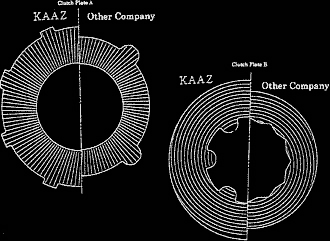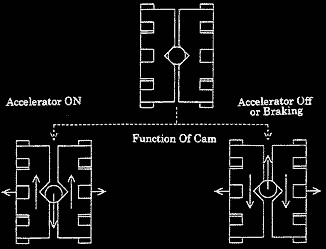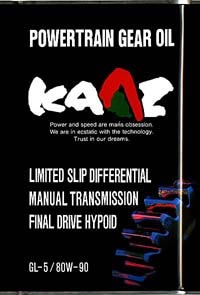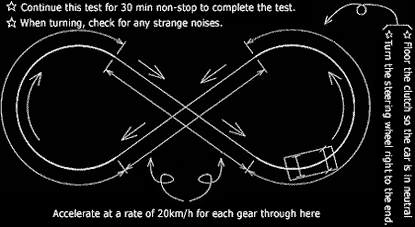Frequently Asked Questions
General Questions:
• Why should I buy a Kaaz Limited Slip Differential?
• What is the difference between 1.5-way or 2-way L.S.D.?
• Where does the L.S.D. mount on the vehicle?
• What type of gear oil should I use?
• Why is break-in important?
Trouble Shooting Questions:
• What is the noise I'm hearing in my new Kaaz L.S.D.?
• Why does this noise occur?
• How do I fix the chattering noise?
________________________________________
General Questions:
Why should I buy a Kaaz Limited Slip Differential?
You might think, "Why should I buy a Kaaz unit when I can buy from the car manufacturer themselves?" Well, we'll show you below.
The following diagram shows the KAAZ clutch plate compared with another typical brand.

See the difference in size. If you'd like, you can view an exploded view photo of the Kaaz L.S.D. that helps to show the overall construction. The most important factor of an L.S.D. is the friction between the clutch plates. The plates cannot slip when they are not meant to, otherwise the L.S.D. is of no use. A bigger plate will have larger surface contact area and provides better grip between plates. Since friction causes heat, our L.S.D. utilizes maximum allowable plate sizes in order to distribute the heat evenly so the plates don’t overheat and cause problems.
Besides the larger size, our plates are made from special materials to improve the effectiveness of our L.S.D.
Back to General Questions Index | Back to Trouble Shooting Questions Index
________________________________________
What is the difference between 1.5-way or 2-way L.S.D.?
Sometimes you will hear these terms used in the business of L.S.D. trading and the racing department, etc. but what does it mean? As we mentioned before, when the accelerator is stepped on, the L.S.D. comes into use. But what if you are braking through a turn? 1-Way L.S.D. means that only when the accelerator is stepped on, the L.S.D. comes into use. The 1.5-Way L.S.D. means that when the car is braking, there is little L.S.D. effect and the 2-Way L.S.D. means that either when the car is accelerating or braking the L.S.D. is always active. The difference between these are the shaping of the cam into different shapes for the pinion to fit. The diagram below shows how the 2-way version of the Kaaz L.S.D. operates.

________________________________________
[/B]Where does the L.S.D. mount on the vehicle?[/B]
For every different type of car, the L.S.D. is fitted on different places. As we all know, the cars are separated into following categories: FR, FF, MR, RR and 4WD. Basically the L.S.D. is fitted between the 2 wheels that the drivetrain uses to propel the car. On 4WD cars, 3 L.S.D. are fitted. One in the front, one in the center and one at the rear of the car.
________________________________________
What type of gear oil should I use?
A special blend oil made by KAAZ named "PowerTrain Gear Oil" can be used to keep your L.S.D. running for long hours under the best condition. The oil helps the clutch plates to grip and slip when needed.

KAAZ PowerTrain Gear Oil works for all transmission/L.S.D. uses.
1. Our gear oil can be used on front drive manual transmission and rear drive final gear.
2. Our gear oil has the capability of improving your L.S.D.’s performance, giving your L.S.D. a longer lasting life and removing unnecessary noises form the L.S.D.
3. Unlike some other gear oil, at normal temperature, our gear oil flows fluently between the gears in order to decrease friction loss from the beginning of your drive. This not only will give you a comfortable drive but also help save fuel consumption.
4. Our gear oil has the characteristic of low friction loss and at the same time provides high lubrication.
KAAZ PowerTrain Gear Oil is available in 2 liter containers.
CAUTION!!! Do not use the KAAZ PowerTrain gear oil on automatic transmission vehicles.
Why is break-in important?
When the L.S.D. comes out of the factory, it has been thoroughly washed, but some iron dust and dirt particles may still exist in between the clutch plates. The clutch plates do not fit perfectly from the very beginning, therefore this causes some jumping effect. Applying too much torque when the unit is new will cause damage to the clutch plates and may result in plates forming an angle fit. Once these plates forms an angle fit, the L.S.D. is unable to function at 100% efficiency. Damaging the clutch plates will decrease it’s lifetime.
When the break in is done properly and the clutch plates form a perfect fit, not only the L.S.D. can be functioning at 100% efficiency but the lifetime of the unit will be longer than expected. Just like fitting a new brake pads, if you floor the brake pedal right away the brake pad’s ability to stop the car will decrease. Therefore, you have to let the brake pads and the brake disc rub and form a good fit before hard use. L.S.D. is the same way, initial form fitting is very important.
Information about the break in is found in the instruction booklet that comes with each unit. Every manufacturer of L.S.D. has their own way of break in procedures. Please follow the instructions that come with each unit. After the initial break in procedure, L.S.D. oil must be changed. Check the oil drained after the break in, you will find lots of iron grains from the friction of the plates rubbing to form a good fit. You can then visually see the importance of the break in and oil change.
[/B]Trouble Shooting Questions:[/B]
What is the noise I'm hearing in my new Kaaz L.S.D.?
When a new mechanical L.S.D. is installed, it usually gives out strange noise. This noise comes from the different friction forces of the clutch plates.
Why does this noise occur?
The noise occurs when the L.S.D. is effective and the clutch plates are rubbing against each other. The vibration of the friction produces this noise. The noise is most likely produced when driving at low speed or backing into the garage. When the clutch plates rub together for some time it will form a perfect fit between plates and the noise will disappear.
Some new and larger L.S.D.s we make are made with larger plates to maintain more torque. Some of these larger L.S.D.s will produce some chattering noise even after the initial break in. Please do not think that chattering noise is normal when using a mechanical L.S.D. If you follow the correct installation and break-in procedures, the noise will be gone from your L.S.D. in no time.
How do I fix the chattering noise?
We understand that most car owners who use the mechanical L.S.D. are very disturbed by the chattering noise. As mentioned previously, the chattering noise comes from the friction between the clutch plates. This situation is normally caused by not doing enough break in and bad angle fit between the clutch plates.
The best to break in and remove the noise is by driving in a “figure 8” pattern as shown below for about 30 minutes and let the plates rub in to form a good fit. If this initial break in is not performed and too much torque is applied to the L.S.D. at once, the plates will form strange angles. Then the chattering noise will continue and may even cause damage to the L.S.D.

The oil used in the L.S.D. could also contribute to the noise problem. Poor quality oils contain large amount of tiny grains of metal which cause chattering noises. If noise still occurs after break in, try changing the L.S.D. oil. This usually eliminates or reduces the noise. Oil which contains large amount of added chemicals will cause noise too. Users who are especially concerned about the chattering noise could think about changing to a better quality oil such as KAAZ Powertrain Gear Oil.
________________________________________
KAAZ U.S.A.
(949) 631-0990
(888) 522-KAAZ
fax at (949) 631-0909
newportcars@kaazusa.com
General Questions:
• Why should I buy a Kaaz Limited Slip Differential?
• What is the difference between 1.5-way or 2-way L.S.D.?
• Where does the L.S.D. mount on the vehicle?
• What type of gear oil should I use?
• Why is break-in important?
Trouble Shooting Questions:
• What is the noise I'm hearing in my new Kaaz L.S.D.?
• Why does this noise occur?
• How do I fix the chattering noise?
________________________________________
General Questions:
Why should I buy a Kaaz Limited Slip Differential?
You might think, "Why should I buy a Kaaz unit when I can buy from the car manufacturer themselves?" Well, we'll show you below.
The following diagram shows the KAAZ clutch plate compared with another typical brand.

See the difference in size. If you'd like, you can view an exploded view photo of the Kaaz L.S.D. that helps to show the overall construction. The most important factor of an L.S.D. is the friction between the clutch plates. The plates cannot slip when they are not meant to, otherwise the L.S.D. is of no use. A bigger plate will have larger surface contact area and provides better grip between plates. Since friction causes heat, our L.S.D. utilizes maximum allowable plate sizes in order to distribute the heat evenly so the plates don’t overheat and cause problems.
Besides the larger size, our plates are made from special materials to improve the effectiveness of our L.S.D.
Back to General Questions Index | Back to Trouble Shooting Questions Index
________________________________________
What is the difference between 1.5-way or 2-way L.S.D.?
Sometimes you will hear these terms used in the business of L.S.D. trading and the racing department, etc. but what does it mean? As we mentioned before, when the accelerator is stepped on, the L.S.D. comes into use. But what if you are braking through a turn? 1-Way L.S.D. means that only when the accelerator is stepped on, the L.S.D. comes into use. The 1.5-Way L.S.D. means that when the car is braking, there is little L.S.D. effect and the 2-Way L.S.D. means that either when the car is accelerating or braking the L.S.D. is always active. The difference between these are the shaping of the cam into different shapes for the pinion to fit. The diagram below shows how the 2-way version of the Kaaz L.S.D. operates.

________________________________________
[/B]Where does the L.S.D. mount on the vehicle?[/B]
For every different type of car, the L.S.D. is fitted on different places. As we all know, the cars are separated into following categories: FR, FF, MR, RR and 4WD. Basically the L.S.D. is fitted between the 2 wheels that the drivetrain uses to propel the car. On 4WD cars, 3 L.S.D. are fitted. One in the front, one in the center and one at the rear of the car.
________________________________________
What type of gear oil should I use?
A special blend oil made by KAAZ named "PowerTrain Gear Oil" can be used to keep your L.S.D. running for long hours under the best condition. The oil helps the clutch plates to grip and slip when needed.

KAAZ PowerTrain Gear Oil works for all transmission/L.S.D. uses.
1. Our gear oil can be used on front drive manual transmission and rear drive final gear.
2. Our gear oil has the capability of improving your L.S.D.’s performance, giving your L.S.D. a longer lasting life and removing unnecessary noises form the L.S.D.
3. Unlike some other gear oil, at normal temperature, our gear oil flows fluently between the gears in order to decrease friction loss from the beginning of your drive. This not only will give you a comfortable drive but also help save fuel consumption.
4. Our gear oil has the characteristic of low friction loss and at the same time provides high lubrication.
KAAZ PowerTrain Gear Oil is available in 2 liter containers.
CAUTION!!! Do not use the KAAZ PowerTrain gear oil on automatic transmission vehicles.
Why is break-in important?
When the L.S.D. comes out of the factory, it has been thoroughly washed, but some iron dust and dirt particles may still exist in between the clutch plates. The clutch plates do not fit perfectly from the very beginning, therefore this causes some jumping effect. Applying too much torque when the unit is new will cause damage to the clutch plates and may result in plates forming an angle fit. Once these plates forms an angle fit, the L.S.D. is unable to function at 100% efficiency. Damaging the clutch plates will decrease it’s lifetime.
When the break in is done properly and the clutch plates form a perfect fit, not only the L.S.D. can be functioning at 100% efficiency but the lifetime of the unit will be longer than expected. Just like fitting a new brake pads, if you floor the brake pedal right away the brake pad’s ability to stop the car will decrease. Therefore, you have to let the brake pads and the brake disc rub and form a good fit before hard use. L.S.D. is the same way, initial form fitting is very important.
Information about the break in is found in the instruction booklet that comes with each unit. Every manufacturer of L.S.D. has their own way of break in procedures. Please follow the instructions that come with each unit. After the initial break in procedure, L.S.D. oil must be changed. Check the oil drained after the break in, you will find lots of iron grains from the friction of the plates rubbing to form a good fit. You can then visually see the importance of the break in and oil change.
[/B]Trouble Shooting Questions:[/B]
What is the noise I'm hearing in my new Kaaz L.S.D.?
When a new mechanical L.S.D. is installed, it usually gives out strange noise. This noise comes from the different friction forces of the clutch plates.
Why does this noise occur?
The noise occurs when the L.S.D. is effective and the clutch plates are rubbing against each other. The vibration of the friction produces this noise. The noise is most likely produced when driving at low speed or backing into the garage. When the clutch plates rub together for some time it will form a perfect fit between plates and the noise will disappear.
Some new and larger L.S.D.s we make are made with larger plates to maintain more torque. Some of these larger L.S.D.s will produce some chattering noise even after the initial break in. Please do not think that chattering noise is normal when using a mechanical L.S.D. If you follow the correct installation and break-in procedures, the noise will be gone from your L.S.D. in no time.
How do I fix the chattering noise?
We understand that most car owners who use the mechanical L.S.D. are very disturbed by the chattering noise. As mentioned previously, the chattering noise comes from the friction between the clutch plates. This situation is normally caused by not doing enough break in and bad angle fit between the clutch plates.
The best to break in and remove the noise is by driving in a “figure 8” pattern as shown below for about 30 minutes and let the plates rub in to form a good fit. If this initial break in is not performed and too much torque is applied to the L.S.D. at once, the plates will form strange angles. Then the chattering noise will continue and may even cause damage to the L.S.D.

The oil used in the L.S.D. could also contribute to the noise problem. Poor quality oils contain large amount of tiny grains of metal which cause chattering noises. If noise still occurs after break in, try changing the L.S.D. oil. This usually eliminates or reduces the noise. Oil which contains large amount of added chemicals will cause noise too. Users who are especially concerned about the chattering noise could think about changing to a better quality oil such as KAAZ Powertrain Gear Oil.
________________________________________
KAAZ U.S.A.
(949) 631-0990
(888) 522-KAAZ
fax at (949) 631-0909
newportcars@kaazusa.com


Comment